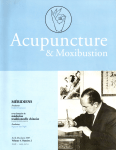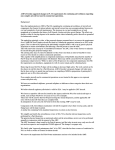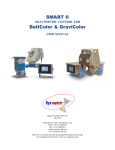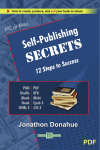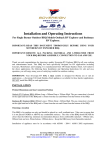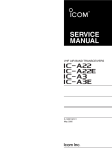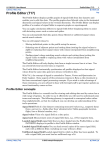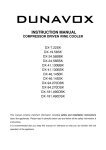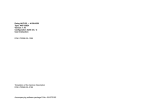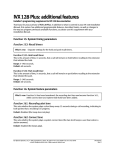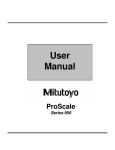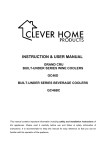Download OK key - Harmony Medical
Transcript
User’s Manual User’s Manual English version 2.1 2009-10 Please read this document first before operate the unit. Classic4 User's Manual 2.1 1 Unit picture Classic 4 Combination of Electroacupuncture TENS/EMS Classic4 User's Manual 2.1 2 Contents Safety Issues 4 - 13 Features 14 - 15 Layouts 16 - 18 Control Keys, Cursor and Signs 19 - 24 Menus and Functions 25 - 41 Operating the Unit 42 - 49 Trouble shooting 50 - 52 Technical Data 53 - 61 Manufacturer 62 - 65 Classic4 User's Manual 2.1 3 Important Safety Instructions • Do read this instruction manual first to ensure proper operation. • Do keep this manual in a safe place for future reference. • Do not drop this device, and keep it away from water or other fluids. • Never use the Classic 4 when it is not functioning properly or when it is damaged. Classic4 User's Manual 2.1 4 Requirements Before using the Classic 4 with patients you should have received some training in EA and/or TENS/EMS, know how to set up and use equipment correctly, and feel competent in its use. You should also have familiarised yourself with the Classic 4 and this instruction manual. Your equipment should be thoroughly and regularly checked (at least once each year) to ensure it is performing correctly, and if a device-related adverse incident occurs, you should report this immediately to HMD Europe Ltd. Finally, ensure that the practice of EA and/or TENS/EMS is covered in your current malpractice and public/products liability insurance policy. If not, you must check with your insurers that additional cover can be provided for these as adjunctive therapy under your policy. Classic4 User's Manual 2.1 5 Safety Warning This equipment may be affected by electromagnetic interference. Also the Classic 4 may affect other electrical equipment in the close vicinity. If such effects are suspected either switch off the offending equipment or increase the distance between the affected equipment and that suspected of causing the interference. The devise may be sensitive to static discharge, to avoid risks or damage to the unit, do connect to patient before turn on. Classic4 User's Manual 2.1 6 Intended Purpose The Classic 4 stimulator is intended to be used by professionals in the disciplines of Physiotherapy, Acupuncture, Sports Medicine or related. The device is used for electrical stimulation in a TENS /EMS (transcutaneous nerve and muscle electrostimulation) or electro-acupuncture protocol, in conjunction with usage of electrodes or acupuncture needles. There could be scope for its use by patients after having been instructed by their practitioner / doctor, who should be satisfied of the appropriateness of this decision. Classic4 User's Manual 2.1 7 Indications Indications for EA In general, EA can be used for any condition for which acupuncture is indicated, especially when manual stimulation has not brought a response or when stronger stimulation (reduction) is appropriate. For example, it has been used to reduce pain, help repair nerve damage, decrease inflammation, retard muscle atrophy, relax or strengthen muscle in cases of paralysis, improve microcirculation and tissue repair, and aid relaxation and drug withdrawal. Indications for TENS TENS is used for the symptomatic management of acute and non-malignant chronic pain. It has also been used for cancer pain in palliative care, and for nausea. Classic4 User's Manual 2.1 8 Contra-Indications Electro-Stimulation Therapy, TENS/EMS or Electro-Acupuncture should not be used by anyone with a cardiac pacemaker. It should not be used in pregnancy or by people with serious disease unless it is part of an intended treatment protocol. Classic4 User's Manual 2.1 9 Contraindications to EA and TENS a brief checklist • • • • • Undiagnosed pain Cancer Epilepsy Pregnancy Patient fitted with a pacemaker or other implanted electronic device • All patients should be advised NOT to use TENS while driving or operating hazardous equipment Classic4 User's Manual 2.1 10 Where not to stimulate • • • • • • • Over the front of the neck or the carotid sinus (at the side of the neck) So that current flows through the brain or heart Where there are skin conditions such as eczema Where there is abnormal skin (or muscle) sensation. In this case, electrodes (or needles) should be positioned elsewhere to ensure effective stimulation At contraindicated acupuncture points. When using the Classic 4 for EA, ensure that you do not apply currents of more than 20 mA, and that you use the ‘B’ (biphasic) and not the ‘M’ (monophasic) waveform. Never attempt to use a device designed solely for TENS for EA. Please refer to your prior training notes for details. If in doubt, do not treat in these circumstances, and always liase with a patient’s medical practitioner or consultant. Classic4 User's Manual 2.1 11 Parameters to use For low-frequency, ‘acupuncture like’ stimulation (ALS, 2-10 Hz), it is generally thought that amplitude should be strong, but not painful. For highfrequency, ‘TENS-like’ stimulation (TLS, 80-175 Hz), stimulation should be definitely feel able, but not uncomfortable. There is some agreement in the literature that ALS is more appropriate for chronic pain and flaccid paralysis, with TLS more often recommended for acute pain and spasticity. However, individuals vary in their response to electrical stimulation. Sometimes it is a matter of trial and error to find which particular combination of parameters is most effective for a particular patient. Adjusting the pulse duration may improve results in some circumstances, as may the use of ‘dense-disperse’ stimulation (alternating low and high frequencies), or simultaneous application of different parameter combinations at different locations. The Classic 4 gives much scope for exploring such variation. For more details, see the references below. Classic4 User's Manual 2.1 12 Where to position needles and surface electrodes EA: Points may be selected from local (ashi or trigger) and distal points, huatuojiaji and auricular points, and also from most of the points that you would normally use as an acupuncturist for systemic or syndrome-based treatment. TENS: Useful illustrations of electrode placements can be found at www.harmonymedical.co.uk • Note that TLS is more effective when used locally or in an area segmentally related to where the condition is focused, but that ALS may be effective when applied elsewhere as well. Classic4 User's Manual 2.1 13 Features (1) • Versatile electro-therapy for treatment of a wide spectrum of TCM patterns or physical conditions. • The facility to use different output parameters within the same treatment session. • The ability to use concurrently as an electro acupuncture stimulator and a TENS/EMS unit. Classic4 User's Manual 2.1 14 Features (2) • • • • • 3 Output Modes (Single, Paired, Sync) 4 Output Channels 24 pre-set frequency settings 0.5 Hz – 200 Hz 20mA capped, can be raised to maximum of 60mA output current • 28 pre-set programmes • 8 user-defined programmes Classic4 User's Manual 2.1 15 Unit Layout 1. On/Off switch 2. Output channel sockets 3. Communication port 4. Screen 5. Control keys 6. Adaptor socket 7. Battery compartment Classic4 User's Manual 2.1 16 Screen Layout (1) • The screen of Classic 4 is divided into a table with 5 columns and 11 rows. • Each entry in the 1st column shows what parameters are used for that row in the other four columns of the table • The top row shows the number of channel Classic4 User's Manual 2.1 17 Screen Layout (2) • Number of output channel • Electrical parameters • Low Battery Indicator • Working area • Pop-up menu Classic4 User's Manual 2.1 18 Control Keys (1) Esc Key. Cancel action or selection, go back to previous action. Menu Key. Choose from a list of actions. The main Menu includes Start/Stop options, selection of output Modes, Load and Save programmes, and Reset. OK key. To CONFIRM and accept selected / changed value. Up Key. Press to move the cursor Up or Click to INCREASE value inside and Active Cell. (Note: keep this key pressed for rapid increase) Down Key. Press to move the cursor Down or Click to DECREASE value inside and Active Cell. (Note: keep this key pressed for rapid increase) Classic4 User's Manual 2.1 19 Control Keys (2) Left Key. Move LEFT to previous channel from current cursor position. Right Key. Move RIGHT to next channel from current cursor position. FN Key. Function key can be used in combination with other Control Keys for rapid action. COM Key. Com key can be used in combination with other Control Keys for external communication and applications. (Note. The function of this key is currently under development and is not available to the user at this version.) Classic4 User's Manual 2.1 20 Channel and Cursor Channel is Active Active in High Current Channel is Faulty When Channel Active sign is turned ON, it indicates the channel is ready for treatment use. When an active channel is operated beyond 20mA, the icon is changed from hollow to a solid lighting symbol. When Channel Faulty sign is turned ON, the output amplitude of that channel is automatically shut down. Cursor Cell The highlighted Cell is the current position of your cursor. Active Cell An Active Cell is indicated with an Up/Down arrow sign inside the cell. You can change the value in the cell by using the Up / Down Control Keys. Classic4 User's Manual 2.1 21 Select Output Channel • The output sockets are located at the top of your unit. When the unit is turned on, the screen presents a table with 5 columns. The left column lists all available parameters. The remaining 4 columns, with headings numbered 1 to 4, correspond to output channel sockets 1 to 4. • When the cursor is within the chosen Channel (column), press the Menu Key to apply an option or to activate the output channel with the Start command. Classic4 User's Manual 2.1 22 Activated Channel When the Start key is selected, the activated channel(s) will be identified by a small lightning icon next to the channel number(s) and the treatment time count will start counting down. Each channel is capped at 20mA for safety operation in electroacupuncture. To operate a channel beyond 20mA, press the FN key when the intensity reaches 20mA, the lightning icon is changed from hollow to solid. Classic4 User's Manual 2.1 23 Faulty Channel • When the X sign appears next to a channel accompanied by a sound (bleep) this indicates that there is an error on the channel. • The output of that channel is automatically cut off. • Read the “Trouble shooting” section of this manual to rectify problem. Classic4 User's Manual 2.1 24 The Main Menu • When the Menu Key is pressed, the Main Menu appears if the cursor is on a channel that is not activated. • The Main Menu presents all the options for operating your device. • Use the Up/Down keys to scroll to desire option, press the OK key to confirm. Classic4 User's Manual 2.1 25 Single Mode • Selecting this option allows you to set any parameter for any for a single channel independently of those chosen for the other three. With the cursor on the chosen channel, it can be activated by selecting the Start option. • Note: no connecting bars between the channel numbers. Classic4 User's Manual 2.1 26 Paired Mode • Selecting this option will set the parameters for channels 1 and 2 as a pair, and those for channels 3 and 4 as a second pair. • In this mode, the parameters set for either member of a pair of channels will automatically be copied to the other one (except for the Timer duration, and amplitude once the channels have been started). The pulses from the two paired channels will be synchronised. Classic4 User's Manual 2.1 27 Sync Mode • Selecting this option will set channels 1, 2, 3 and 4 to run in synchrony. • In this mode, the parameters set for channel #1 will be automatically be copied to the other three (except for the Timer duration, and amplitude once the channels have been started). The pulses from the four channels will be synchronised. • Sync Mode is the factory pre-set default. Classic4 User's Manual 2.1 28 Start Start – to start the selected channel after locating the cursor on its column. The activated channel(s) will be identified by a small lightning icon next to the channel number(s) and the treatment time count will start counting down. Classic4 User's Manual 2.1 29 Stop/Stop All Menu • When the Menu Key is pressed, and the cursor is on a channel that is activated, the Stop/Stop All menu appears on-screen. • Use the Up/Down keys to scroll options, and press the OK key to confirm. Stop – to stop output to the selected channel. Stop All – to stop output to all active channels Classic4 User's Manual 2.1 30 Reset parameters Reset Values - when this option is highlighted and the OK key is pressed, the parameters will be reset to the values previous installed for the selected Channel. Classic4 User's Manual 2.1 31 Parameters (1) Output current amplitude in mA Treatment duration timer (0 – 90 minutes) Repetition frequency of 1st set of pulses Width of 1st set of pulses in microseconds Burst duration for 1st set of pulses in seconds Classic4 User's Manual 2.1 32 Parameters (2) Repetition frequency of 2nd set of pulses Width of 2nd set of pulses in microseconds Burst duration for 2nd set of pulses in seconds The types of change from 1st pulses to 2nd pulses. Ramped or Step. Waveform: symmetrical biphasic or monophasic Classic4 User's Manual 2.1 33 Set the Parameters The Classic 4 is a versatile and powerful stimulator. You can set the frequency, pulse waveform, pulse duration, and timing of each set of pulses and channel according to your clinical needs. You can fine-tune and modify your settings rapidly in various ways. The basic methods are: • Load preset parameters • Load saved parameters • Set your own parameters Classic4 User's Manual 2.1 34 Set your own parameters (1) The parameters f1 (frequency #1), p1 (pulse width #1) and t1 (duration of 'on' time #1) refer to an interval of duration t1 during which pulses are emitted at a repetition frequency f1 and with a pulse width p1. The parameters f2 (frequency #2), p2 (pulse width #1) and t2 (duration of 'on' time #2) refer to an interval of duration t2 during which pulses are issued at a repetition frequency f2 and with a pulse width p2. At the end of time t1, the characteristics of the pulses (f1, p1, t1) will change to those of the second set of pulses (f2, p2, t2). Subsequently, at the end of this second interval (t2) the parameters will revert to those of the first set for the duration of t1, and so on. Classic4 User's Manual 2.1 35 Set your own parameters (2) If t2 is set to zero, the pulses will run continuously with the settings for the first set of pulses (f1, p1, t1). To change any of these parameters, position the cursor on the desired one, and then press the OK key. A small window will open and the value inside the window can be changed up or down by pressing the Up key or the Down key. A quick press will change the value to the next one, whereas keeping the button pressed will scan through the available values. Classic4 User's Manual 2.1 36 List of Presets (1) Presets Name f1 Hz p1 us t1s f2 Hz p2 us t2s f1-f2 M/B 2 Hz C 2 256 3 2 256 0 Stepped Bipolar 5 Hz C 5 256 3 5 256 0 Stepped Bipolar 10 Hz C (Default) 10 128 3 10 128 0 Stepped Bipolar 10 Hz Short pulse 10 64 3 10 64 0 Stepped Bipolar 80 Hz C (Gate Control) 80 128 3 80 128 0 Stepped Bipolar 100 Hz C 100 128 3 100 128 0 Stepped Bipolar 150 Hz C 150 64 3 150 64 0 Stepped Bipolar 0.5/1 Hz (Min setting) 0.5 64 3 1 64 3 Stepped Bipolar 0.5/10 Hz (Unequal pulses) 10 192 5 0.5 256 3 Ramping Bipolar 0.5/80 Hz Equal pulses 0.5 128 6 80 128 6 Stepped Bipolar 2/15 Hz (Equal pulses) 15 192 3 2 192 3 Stepped Bipolar 2/80 Hz (Equal pulses) 2 192 3 80 192 3 Stepped Bipolar 2/80 Hz (Short pulse) 2 64 3 80 64 3 Ramping Bipolar 100 128 3 2 192 3 Stepped Bipolar 2/100 Hz (Unequal pulses) Classic4 User's Manual 2.1 37 List of Presets (2) Presets Name 60/80 Hz Stepped f1 Hz p1 us t1s f2 Hz p2 us t2s f1-f2 M/B 60 64 10 80 64 10 Stepped Bipolar 2 Hz (Pulse Modulated) 2 256 2 2 64 2 Stepped Bipolar 80 Hz (Pulse modulated) 80 192 2 80 64 2 Stepped Bipolar 20 Hz Burst 20 192 5 20 0 3 Ramping Bipolar 100 128 3 100 0 3 Stepped Bipolar 10 64 3 10 64 0 Ramping Bipolar 200 Hz C (R) 200 64 2 200 64 0 Ramping Bipolar 0.5/10 Hz (R) 0.5 256 3 10 192 5 Ramping Bipolar 2/80 Hz (R) 80 64 3 2 192 3 Ramping Bipolar 60/80 Hz (R) 60 64 10 80 64 10 Ramping Bipolar 80 Hz (Pulse Ramp) 80 192 3 80 64 3 Ramping Bipolar 50 Hz Burst (R) 50 128 4 50 0 6 Stepped Bipolar 80 Hz Long Burst (R) 80 64 6 80 0 2 Ramping Bipolar 200 Hz short burst (R) 200 64 2 200 0 1 Ramping Bipolar 100 Hz (Burst) 10 Hz short pulse (R) Classic4 User's Manual 2.1 38 Load Presets 1. Select the channel(s), press the Menu key, move the Up/Down keys to select Preset. 2. This option will lead to a new screen opens, as shown to the left. Use the Up/Down keys to scroll through the list of presets. The preset parameters are shown in the right column. Press the OK key on the desired set. 3. This will load the relevant parameters and copy them over into your selected channel(s) in the left column. Classic4 User's Manual 2.1 39 Load Your Favourite 1. Select the channel where you want your favourite to be loaded. 2. Press the Menu key, move the Up/Down keys to select Load. A new window opens, as shown in the left. 3. Use Up/Down keys to flick through your saved favourite as in User P1 to P8, click OK key to confirm. 4. The left column shows values of your existing channel, the right column shows the stored values. Classic4 User's Manual 2.1 40 Save Your Favourite 1. This option will lead to a second screen as shown on the left. Eight User slots are available. 2. Use the Up/Down keys to select which slot you want to save your parameters. Existing parameters in the slot will be over-written with your new values. 3. The values saved are taken from the single chosen channel only. Classic4 User's Manual 2.1 41 Starting the Treatment Preparation • • • • • • Prepare your patient for treatment – keep your patient calm and relaxed. Switch ON the Classic 4 stimulator. Check that the screen lights up showing all channels and the low battery indicator is not on. Switch OFF the Classic 4. Insert output cables in channel sockets. Connect output cable(s) to your patient. Turn ON the Classic 4 again. The unit is ready to use. Classic4 User's Manual 2.1 42 Instruction for use with acupuncture needles 1. 2. 3. 4. 5. 6. 7. Determine the Output mode for your unit. Populate parameters for each channel you want to use. Set the treatment timer for each output channel. Connect output wires to needles/electrodes. Move cursor to highlight the channel you want to begin, press Menu key, use Up/Down keys to highlight Start option, press the OK key. The channel is now active. An Active cell opens. Use the Up/Down keys to increase the intensity as appropriate, pressing the OK key to lock the current intensity. Repeat steps 5 to 6 for the other channels you wish to use. The treatment timer counts down automatically once the channel is set to Start, and turns the channel off at this point when it reaches zero. An audio sound is also emitted. Classic4 User's Manual 2.1 43 Making adjustments during treatment 1) 2) 3) • To adjust the current intensity, go to that channel, press the OK key so that the cell is Active, use the Up/Down keys to make your adjustment, and confirm with OK key again. To increase/decrease duration of the treatment session, move the cursor to where the channel and treatment timer (row) meet, press the OK key so that the cell is Active, use the Up/Down keys to increase/decrease the timer setting, and press the OK key again to confirm. Each channel is capped at 20mA for safety in electroacupuncture, to increase beyond 20mA, press the FN key, and use the Up key to increase, and confirm with OK key again. For safety and the patient's comfort, in both Sync and Paired Output modes only the output current intensity and treatment timer are adjustable during a treatment session without resetting the channel. In the more advanced Single Output mode, you can make adjustments to all parameters. However, there will be a timed delay before these changes take place. Classic4 User's Manual 2.1 44 Stop and Resume a Treatment • To stop or pause a channel or pair of channels, move your cursor to the channel you wish to pause or stop, press the Menu key to open the Stop submenu, select Stop to stop the highlight channel, or Stop All channels. This sets the current of selected channel gently to zero, and the treatment timer is set to pause. . • To resume treatment, press the Menu key, select Start and adjust the output current again. Classic4 User's Manual 2.1 45 Treatment Completed • When a treatment session is completed, turn off the power. • Disconnect cables from acupuncture needles or electrodes. Then remove plugs from output sockets. Classic4 User's Manual 2.1 46 After Treatment • Replace battery if the Low Battery sign appears during a treatment session. • Remove the battery from the battery compartment if the unit is not required for more than a few days. • Remove the AC/DC adaptor if an external adaptor has been used. Classic4 User's Manual 2.1 47 Storage and Transportation • Store unit in a dry location free from dust and contamination, where the temperature remains constant and within the range of 16ºC to 40ºC (61ºF to 104ºF), humidity between 15% and 95%. • Do not drop or mishandle. During transportation, always secure the unit in its original case or in a protective container. Classic4 User's Manual 2.1 48 Care and Maintenance • Maintenance of the stimulator is limited to periodically wiping clean the unit using a clean, soft, damp cloth with mild soap solution or water. Using other cleaning solutions may damage the unit. • DO NOT IMMERSE STIMULATOR IN ANY CLEANING SOLUTION. • The output leads should be wiped clean with a cloth dampened with mild soap solution and then wiped dry. • The unit can be used life-long, unless it develops a malfunction. It does not have a limited shelf life or a restricted ‘use by’ date. To have your unit serviced or repaired contact an authorized dealer. Classic4 User's Manual 2.1 49 Trouble shooting (1) • If an X sign flashes in the display on a channel, accompanied by an audio sound (beep), the channel is automatically shut down. This may indicate that the channel has been short-circuited, or a cable is disconnected or broken. • If the X sign appears, please investigate the cause(s) of the problem before the channel is reactivated. Classic4 User's Manual 2.1 50 Trouble shooting (2) • When your unit does not respond to any action with your key pads and your screen freezes, turn off the unit by switching off the power. Remove all cables from your unit before turning it on again. Check that the unit operates correctly before re-connecting the cables. Start your treatment again. Classic4 User's Manual 2.1 51 Trouble shooting (3) • Check and replace battery if the screen does not turn on after the unit is switched on. • If the problem still cannot be resolved, the unit should be returned for repair. Do not attempt to repair the unit yourself, but return it to your local authorized dealer, or contact the manufacturer for repair or service. Classic4 User's Manual 2.1 52 Technical Specifications Frequencies: in Hz. 0.5, 1, 1.5, 2, 2.5, 3, 5, 7, 8, 10 15, 18, 20, 25, 30, 40, 50, 60, 80 100, 125, 150, 175, 200 Pulse duration: 0, 64, 128, 192, 256μs Timer (t1 / t2): in second: 0, 1, 2, 3, 5, 10, 30, 60, 120, 240, 600, 900 Waveform: Biphasic symmetrical alternating rectangular pulses (charge balanced), Monophasic rectangular pulses Output modes: Constant, Modulated, Burst, Ramped and User-defined programmes Size: 145x88x20mm Power: 1x9V battery/external adaptor Weight: 260 grams (including battery) Output channels: 4 channels Timer: 5-90 minutes Classic4 User's Manual 2.1 53 Low Battery Indicator The low battery indicator will begin to flash when the battery becomes low. You may continue to use the unit for your current treatment session and replace the battery for your next session. When the low battery indicator flashes with ONE bar showing, please do not start your treatment session, but replace with a new battery immediately. Classic4 User's Manual 2.1 54 Battery Switch off the unit. To change a battery, push open the battery compartment at the back of the unit. Remove the used battery from the battery compartment. Insert a new battery according to the diagram. The device is protected from damage if the battery is inserted incorrectly, but the device may not function correctly. Always check the polarity. Classic4 User's Manual 2.1 55 AC/DC Adaptor • Only use an AC/DC adaptor which is supplied or approved by the manufacturer. The adoptor must suitable for medical devices with the Maximum output 10 VA. • Switch off your Classic 4 and disconnect any connected channel. • Switch off the power supply of your AC/DC adaptor before connecting the plug into Classic 4’s AC/DC socket. • Turn on the power supply first, before switching on your Classic 4. • An adaptor is only supplied as an optional item. Classic4 User's Manual 2.1 56 Communication Port • DONOT remove the protective cap from the Communication Port. • DO NOT connect to the Communication Port. • In the current version of Classic 4, the Communication Port is used by the manufacturer for programming and diagnostic of the device, and is not designed to be used by users. • The communication port will become available for users as add-on devices and applications are developed. Classic4 User's Manual 2.1 57 Standards Classic 4 Stimulator - complies with: 93/42/EEC EN60601-1:2008 EN60601-1-2: 2007 Classic4 User's Manual 2.1 58 Main Unit and Accessories • Main treatment unit • Connecting cable to electrode 1 pc Art No. MA304 4 pcs Art No. MB113 (in four colour - GBYB) • Alligator clips to 2 pin jacks electrode cords 4 pcs Art No. MB160A • User’s Manual (CD) 1 pc Art No. MA3042 • PP3 9 Volts battery 1 pc Art No. MB902 Classic4 User's Manual 2.1 59 Optional Accessories • Carrying Case Art No. MB1084 • AC/DC adaptor Art No. MB1086 • Grip-type connector to 2mm pin Art No. MB120 Classic4 User's Manual 2.1 60 Explanation of Symbols CE mark of conformity. The device confirms with the Essential Requirements for Medical Devices Directive 93/42/EEC as supervised by SGS United Kingdom Limited, Notified Body Number 0120 The manufacturer of the medical device Attention! Consult accompanying documents. TYPE BF APPLIED PART The device is manufactured in the year shown next to the Symbol Contains electronic parts subject to local / national disposal / recycle requirements. IP30 Specification for degrees of protection provided by enclosures (IP code) according to EN 60529 Classic4 User's Manual 2.1 61 Warranty This Classic 4 electrical stimulator is warranted to the initial purchaser against any defects in material and workmanship for a period of twelve months from the date of purchase. If the stimulator is found to be defective within the warranty period, it will be repaired or replaced if returned prepaid to an authorized dealer. This warranty does not cover damage caused by rental, misuse, negligence, accidents and abuse, or alteration or modification of the unit. No liability is held in either tort or contract for any loss or damage, direct, consequential, or incidental arising out of the use, misuse or inability to use this product. Classic4 User's Manual 2.1 62 Declaration of Conformity HMD Europe Limited declares that the medical device describes as Classic 4 has been classified as Class IIa and is in conformity with the essential requirements and provisions of Council Directive 93/42/EEC and in conformity with the national standard transposing harmonised standard EN60601-1:2008, EN60601- 1-2:2007 and is subject to the procedures set out in Annex V of Directive 93/42/EEC under the supervision of Notified Body Number 0120, SGS United Kingdom Ltd London, 6 October 2009. P.Choy Director on behalf of HMD Europe Limited Classic4 User's Manual 2.1 63 Manufacturer H M D Europe Ltd 629 High Road Leytonstone London E11 4PA, UK Tel: +44 (0)20 8558 8205 http://www.hmd-europe.com Classic4 User's Manual 2.1 64 Please record this information and keep this User’s Manual in a safe place for future reference Serial No: _________________________ (located on the back of the device.) Date Purchased: ____________________ Dealer Stamp: Classic4 User's Manual 2.1 65 Resources The following books provide further information: • • • Johnson MI (2008). Transcutaneous electrical nerve stimulation (TENS). In Watson T (Ed.), Electrotherapy: Evidence-based practice (pp. 253-296). Edinburgh: Churchill Livingstone Mayor DF (Ed.). (2007). Electroacupuncture: A practical manual and resource. Edinburgh: Churchill Livingstone. For training in the use of EA or TENS, contact your own professional organisation. If you are an acupuncture practitioner in the UK, the Acupuncture Association of Chartered Physiotherapists (AACP) and British Medical Acupuncture Society (BMAS) run courses on EA. For British Acupuncture Council (BAcC) members or other qualified acupuncturists, courses can be arranged with David Mayor. Classic4 User's Manual 2.1 66 Useful websites: www.electroacupunctureknowledge.com (for information on EA studies) www.electrotherapy.org (for general information on TENS and electrotherapy) www.tens4u.co.uk (for illustrations of electrode placement) www.harmonymedical.co.uk (for supply of medical devices, accessories and general reference) www.aacp.uk.com (for the AACP) www.acupuncture.org.uk (for the BAcC) www.medical-acupuncture.co.uk (for the BMAS) www.welwynacupuncture.co.uk (for David Mayor) Classic4 User's Manual 2.1 67










































































